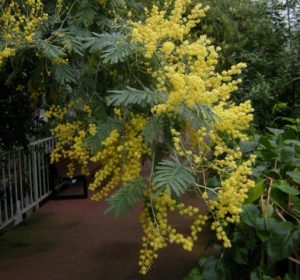Acacia dealbata is an evergreen tree native to the forests of New South Wales, Victoria and Tasmanina, found on slopes and creek banks. It was introduced from Tasmania to the UK in 1820.
The shoots are angular and bear bipinnate, green/blue leaves. The flowers are typical of the genus, being spherical clusters of yellow stamens that are highly fragrant.
The gum is highly soluble in water, and was reputedly dissoved in boiling milk and taken for dysentery and diarrhoea by European settlers. Acacia gum is also an important source of winter carbohydrate for arboreal marsupials. The flowers are used as a fixative in high grade perfume production.

